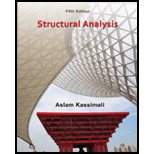
Concept explainers
Draw the influence lines for the reaction moment at support A, the vertical reactions at supports A and F and the shear and bending moment at point E.
Explanation of Solution
Calculation:
Influence line for moment at support A.
Apply a 1 kN unit moving load at a distance of x from left end C.
Sketch the free body diagram of frame as shown in Figure 1.
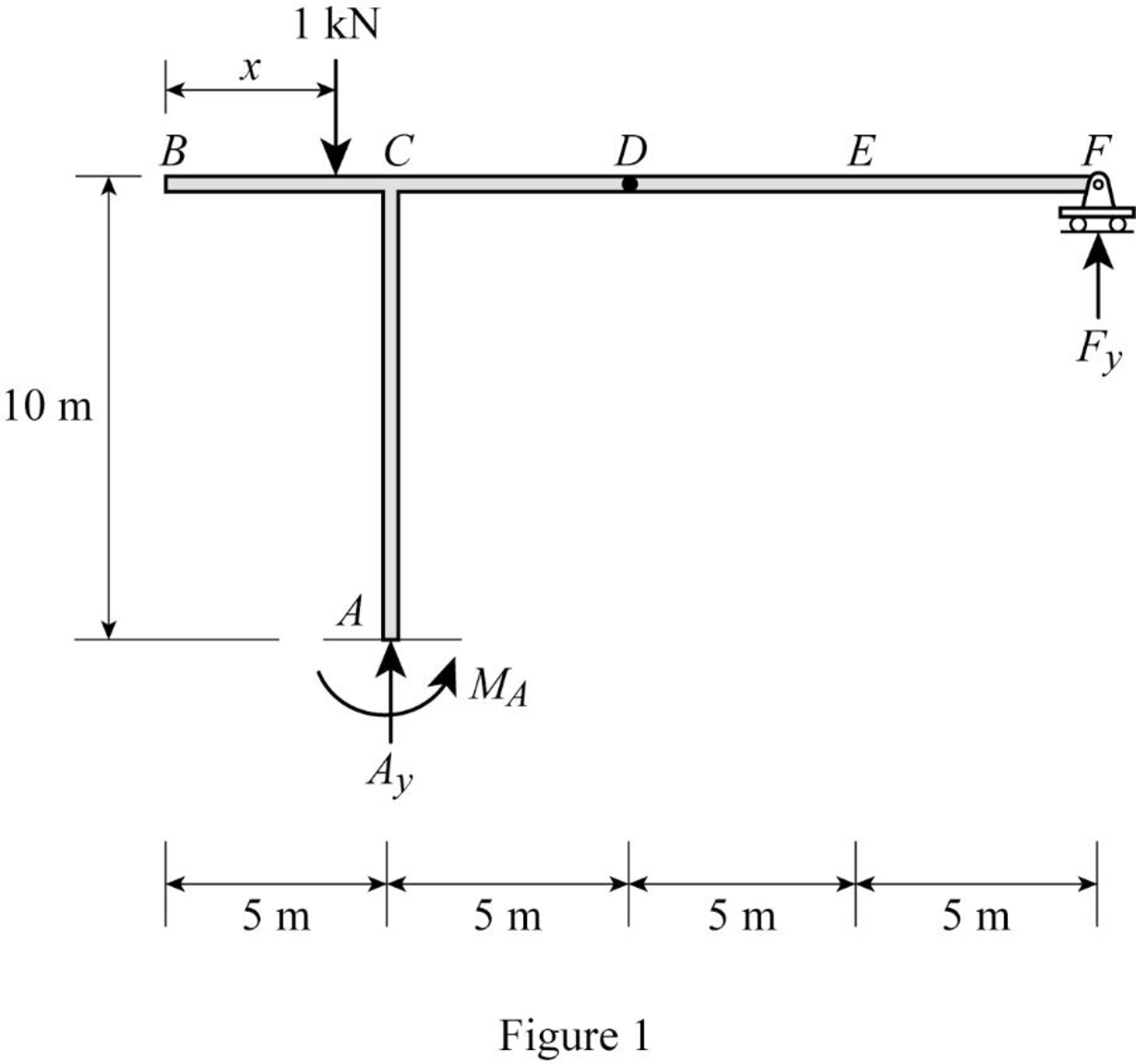
Refer Figure 1.
Apply 1 kN load just left of C
Take moment at A from B.
Consider clockwise moment as positive and anticlockwise moment as negative.
Apply 1 kN load just right of C and just left of D
Take moment at A from D.
Apply 1 kN load just right of D and just right of F
Take moment at A from F.
Thus, the equation of moment at A as follows,
Find the influence line ordinate of
Substitute 0 for
Find the influence line ordinate of
The vertical reaction at F is 1 kN when 1 kN applied at F.
Substitute 20 m for
Thus, the influence line ordinate of
Similarly calculate the influence line ordinate of
| x (m) | Points | Influence line ordinate of |
| 0 | B | ‑5 |
| 5 | C | 0 |
| 10 | D | 5 |
| 20 | F | 0 |
Sketch the influence line diagram for the moment at support A using Table 1 as shown in Figure 2.
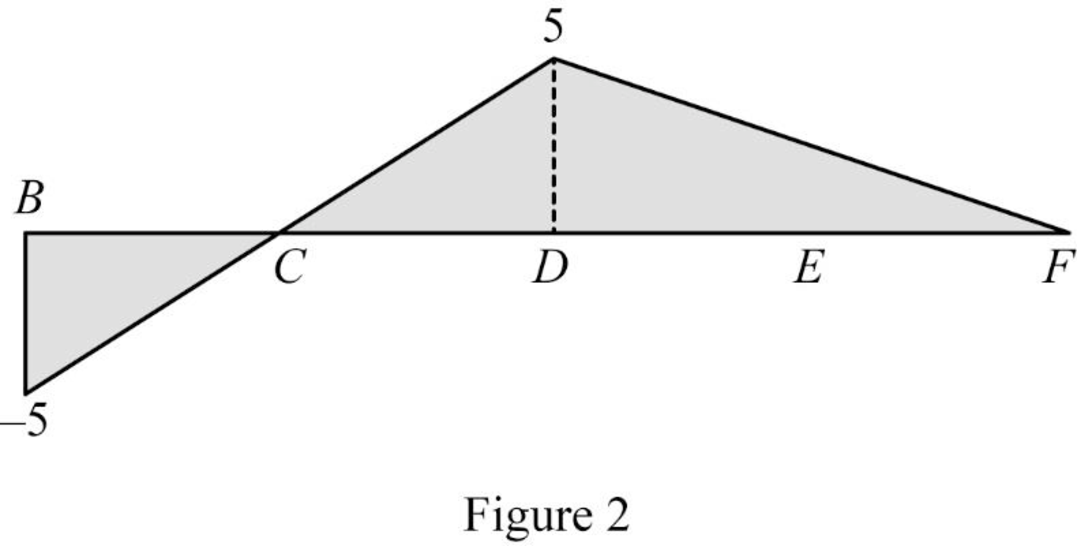
Influence line for vertical reaction at support F.
Apply a 1 kN unit moving load at a distance of x from left end C.
Refer Figure 1.
Find the vertical support reaction
Apply 1 kN load just left of D
Consider section DF.
Consider moment equilibrium at point D.
Consider clockwise moment as positive and anticlockwise moment as negative
Apply 1 kN load just right of D
Consider section DF.
Consider moment equilibrium at point D.
Consider clockwise moment as positive and anticlockwise moment as negative
Thus, the equation of vertical support reaction at F as follows,
Find the influence line ordinate of
Substitute 20 for
Thus, the influence line ordinate of
Similarly calculate the influence line ordinate of
| x (m) | Points | Influence line ordinate of |
| 0 | B | 0 |
| 5 | C | 0 |
| 10 | D | 0 |
| 15 | E | 0.5 |
| 20 | F | 1 |
Sketch the influence line diagram for the vertical reaction at support F using Table 2 as shown in Figure 3.

Influence line for vertical reaction at support A.
Apply a 1 kN unit moving load at a distance of x from left end C.
Refer Figure 1.
Apply vertical equilibrium in the system.
Consider upward force as positive and downward force as negative.
Find the equation of vertical support reaction
Substitute 0 for
Find the equation of vertical support reaction
Substitute
Thus, the equation of vertical support reaction at A as follows,
Find the influence line ordinate of
Substitute 20 m for
Thus, the influence line ordinate of
Similarly calculate the influence line ordinate of
| x (m) | Points | Influence line ordinate of |
| 0 | B | 1 |
| 5 | C | 1 |
| 10 | D | 1 |
| 15 | E | 0.5 |
| 20 | F | 0 |
Sketch the influence line diagram for the vertical reaction at support A using Table 3 as shown in Figure 4.

Influence line for shear at point E.
Sketch the free body diagram of the section BD as shown in Figure 5.
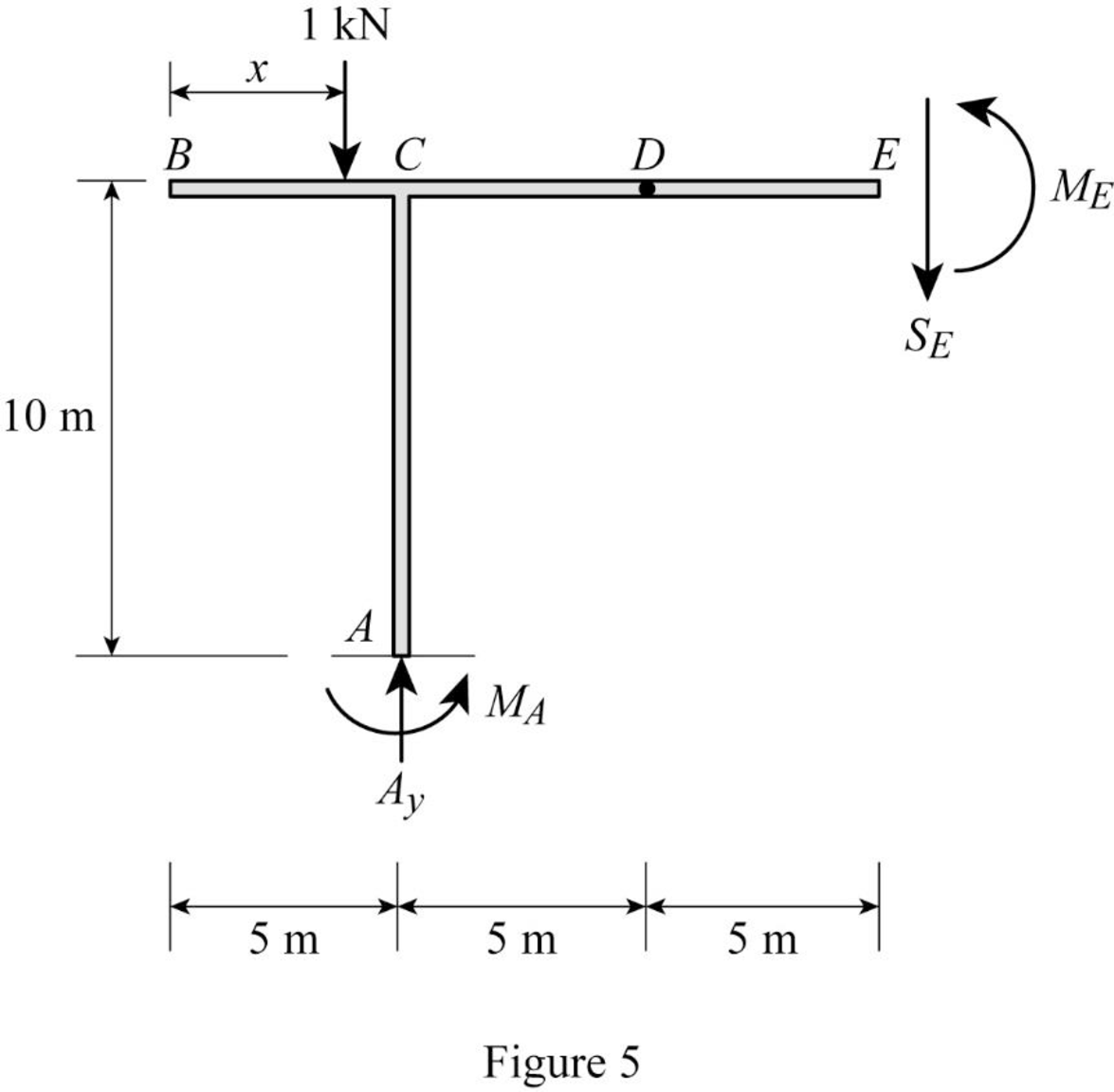
Refer Figure 5.
Apply equilibrium equation of forces.
Consider upward force as positive
Find the equation of shear force at E of portion BD
Substitute
Find the equation of shear force at E of portion DE
Substitute
Find the equation of shear force at E of portion EF
Sketch the free body diagram of the section EF as shown in Figure 6.
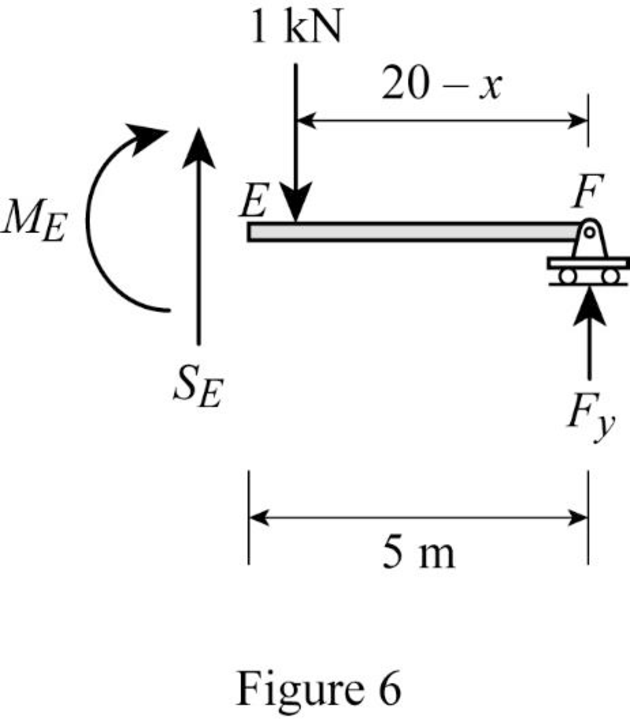
Refer Figure 6.
Apply equilibrium equation of forces.
Consider upward force as positive
Substitute
Thus, the equations of the influence line for
Find the influence line ordinate of
Substitute 15 m for
Thus, the influence line ordinate of
Find the shear force of
| x (m) | Points | Influence line ordinate of |
| 0 | B | 0 |
| 5 | 0 | |
| 10 | 0 | |
| 15 | ||
| 15 | ||
| 20 | F | 0 |
Draw the influence lines for the shear force at point E using Table 4 as shown in Figure 7.
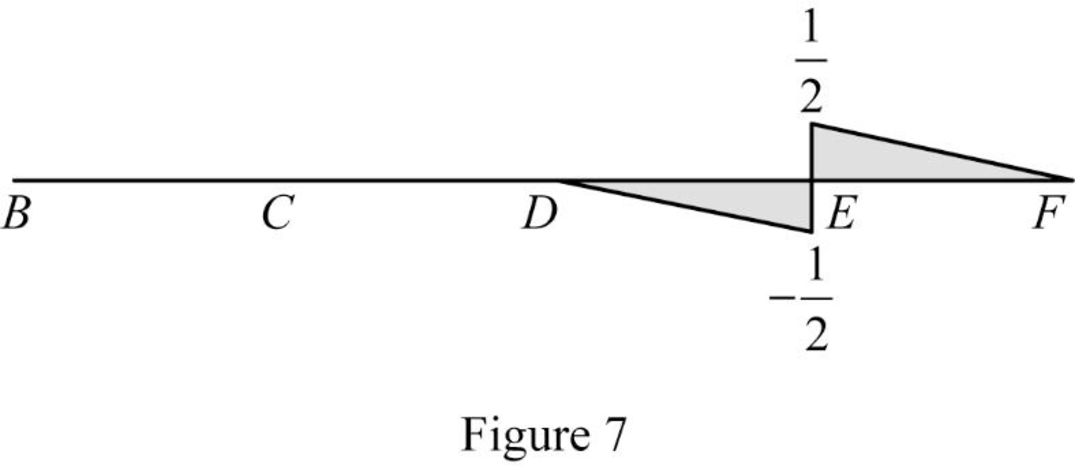
Influence line for moment at point E.
Refer Figure 5.
Consider section BE.
Consider clockwise moment as positive and anticlockwise moment as negative.
Take moment at E.
Find the equation of moment at E of portion BE.
Find the equation of moment at E of portion BD
Substitute
Find the equation of moment at E of portion DE
Substitute
Substitute
Refer Figure 6.
Consider section EF.
Find the equation of moment at E of portion EF
Consider clockwise moment as positive and anticlockwise moment as negative.
Take moment at E.
Find the equation of moment at E of portion EF.
Substitute
Thus, the equations of the influence line for
Find the influence line ordinate of
Substitute 15 m for
Thus, the influence line ordinate of
Find the moment at various points of x using the Equations (5) and (6) and summarize the value as in Table 5.
| x (m) | Points | Influence line ordinate of |
| 0 | B | 0 |
| 5 | C | 0 |
| 10 | D | 0 |
| 15 | E | |
| 20 | F | 0 |
Draw the influence lines for the moment at point E using Table 5 as shown in Figure 8.
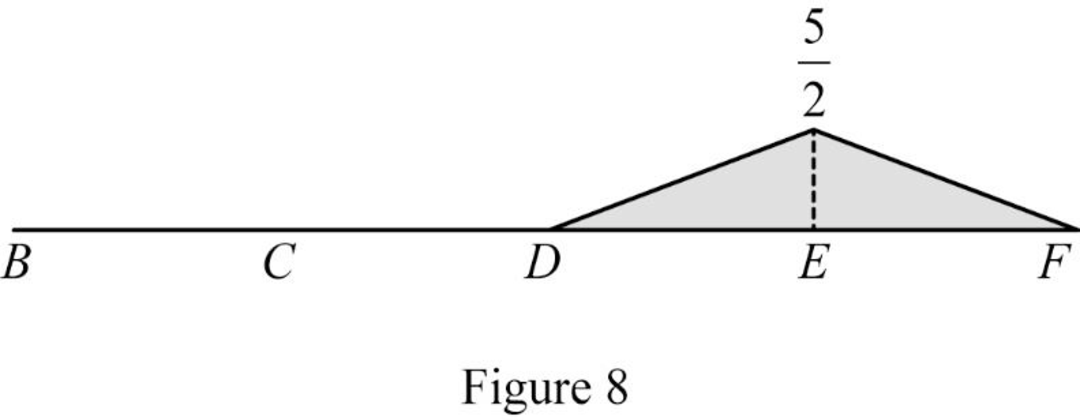
Therefore, the influence lines for the vertical reactions at supports A and F and the influence lines for the shear and bending moment at point E are drawn.
Want to see more full solutions like this?
Chapter 8 Solutions
Structural Analysis (MindTap Course List)
- Thumbi Irrigation Scheme in Mzimba district is under threat of flooding. In order to mitigate against the problem, authorities have decided to construct a flood protection bund (Dyke). Figure 1 is a cross section of a 300m long proposed dyke; together with its foundation (key). Survey data for the proposed site of the dyke are presented in Table 1. Table 2 provides swelling and shrinkage factors for the fill material that has been proposed. The dyke dimensions that are given are for a compacted fill. (1) Assume you are in the design office, use both the Simpson Rule and Trapezoidal Rule to compute the total volume of earthworks required. (Assume both the dyke and the key will use the same material). (2) If you are a Contractor, how many days will it take to finish hauling the computed earthworks using 3 tippers of 12m³ each? Make appropriate assumptions. DIKE CROSS SECTION OGL KEY (FOUNDATION) 2m 1m 2m 8m Figure 1: Cross section of Dyke and its foundation 1.5m from highest OGL 0.5m…arrow_forwardthis is from CE-192arrow_forwardThe head-vs-capacity curves for two centrifugal pumps A and B are shown below: Which of the following is a correct statement at a flow rate of 600 ft3/min? Assuming a pump efficiency of 80%. Head [ft] 50 45 40 35- 30 25 20 15 10 5. 0 0 Pump B Pump A 100 200 300 400 500 600 700 800 900 1000arrow_forward
- Solve for reactions and shear and moment diagram (base the answer on the 2nd figure). Hand Calculation 2. Note: Assume bottom left support as roller, bottom right support as pinned 4 kN/m 3 kN/m 8m 4m 2marrow_forwardYour client wants to build a WTP that has a withdraw of 440 MGD. What is the exceedance probability in percentage? Average Monthly Minimum Flow of Record Month (MGD) Jan-73 322 Feb-73 280 Mar-73 335 Apr-73 374 May-73 440 Mar-74 313 Apr-74 375 May-74 560 Jun-74 380 Jul-74 445 Aug-74 323 Sep-74 411 Oct-74 541 Nov-74 510 Jan-75 261 Feb-75 271 May-75 312 Jun-75 314 351 Jul-75 Aug-75 332arrow_forwardIf a second 12.25" pump was added in parallel what would be the NPSHr be while both pumps are running? HEAD (Feet) 250- 200- Pump Series: VSX-VSC 10x12x13-1/2A 1780 RPM 13.5" 60% 70% -75% 80% 83% -85.5%- 150- 12.25" 100- 50 50- 10" 0- 2,000 NPSHr 83%. 80% 300HP- -75% 250HP 200HP 70% 150HP 125HP 100HP NPSHr(ft) 0 4,000 6,000 8,000 Capacity (GPM) 80 90 8arrow_forward
- Solve for reactions and shear and moment diagram (base the answer on the 2nd figure) 1. Note: Assume bottom support as pinned 14 kN/m 16 kN 6m 5m 3m- 6marrow_forwardA plant treats 25 MGD at 5°C and pH=7.0. The plant uses ozone before the filter and free chlorine after the filter. The ozone contactor has a t10 of 3 minutes and a residual concentration of 0.3 mg/L. The free chlorine contact basin is 65 ft by 214 ft by 10 ft and a baffle factor of 0.5 and a residual concentration of 1.4 mg/Larrow_forwardA3-inch diameter water pipe carries a flow rate of 6 gallons per minute. The pipe is 100 feet long and has a gate valve, two 45-degree elbows, and a sudden c factor for the pipe is 0.02 and the minor loss coefficients for the gate valve, elbows, and contraction are 12, 1.5, and 0.5, respectively. Determine the head loss due to friction and minor losses in the pipe, assuming the water temperature is 68°F and the density of water is 62.4 barrow_forward
- Based on ONLY on the diagram below, how much energy is the pump adding to the system. The pressure gauge Reads 60 psi 20 feet 30 feet 5 feet 1 foot 2 feetarrow_forwardA confined aquifer has a differential drawdown (Ah) of 5 feet. The flow rate (Q) is measured to be 10 gpm. Calculate the transmissivity (T) of the aquifer in gpd/ft.arrow_forwardMatch the term from the Clean Water Act with its corresponding definitions National Pollutant Discharge Elimination System (NPDES) Total Maximum Daily Load (TMDL) Best Available Technology (BAT) Point source pollution A The maximum amount of a pollutant that a water body can receive while still meeting water quality standards. B. A permit program that regulates the discharge of pollutants from point sources into the waters of the United States. C. A specific location, such as a pipe or ditch, from which pollutants are discharged into a water body. D. A technology or treatment method that is determined to be the most effective way to control pollutants based on factors such as cost and feasibility.arrow_forward
